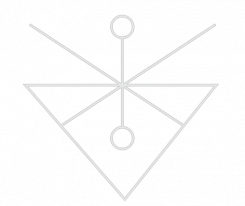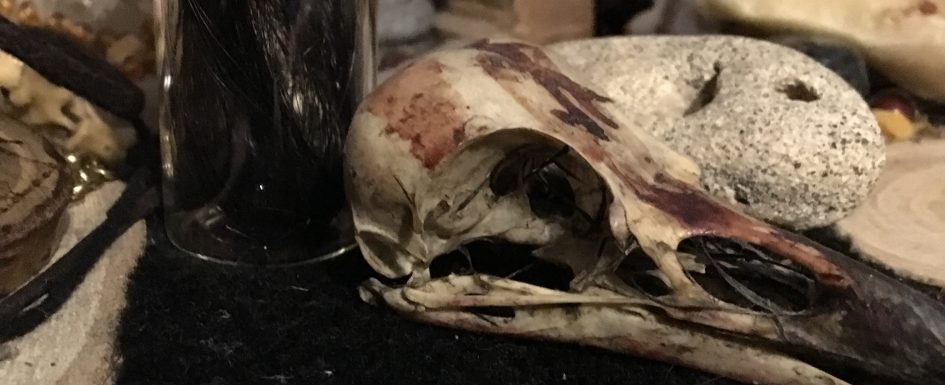Per leggere la versione di questo articolo scritta in italiano clicca qui.
Femininity has always been considered a low form of force/power, even for our Europe: just consider the parallelism that takes place with the arrival of the Indo-European.
Everything non-virile took secondary forms. The practice of witchcraft was seen highly dangerous, esoteric, occult and uterine by the colonizing man of the european lands (see vastness of votive pottery in a considerable area), a form suitable only for men and women aware of their limited physicality (lik).
In this regard, towards the Viking age, i.e. at the beginning of the first manifestations of the Indo-European man, the new “well integrated” and transcribed social conceptions of rules come into play, contained in the codices, sagas and epigraphies. Here the offensive terms emerge, used for men and women who begin witchcraft practice.
With the arrival of the christianization, these terms increase in value and are emphasized in the legislature. With the abrahamic closure, the indigenous and uterine esoteric practices are increasingly hidden and denigrated, up to the present day. These are closed and stemmed with terms “interpreted” by abrahamic masculinity.
Vanatrú has no intention of defending and re-evaluating personal sexual choice in heathen practices.
Our specification does not include defending sexual minority and diversity, as we do not feel it to be our own. We do not care to defend the rights to free choices of others, we simply clarify a huge mistake marked by the patriarchal phases.
Seiðr is the shamanic art of the North, which also includes men and which does not show sectoriality. This art, imbued with “shaman”, has its root in the witchcraft of “folköi” and allows Vanatrú to retrace its nine noble virtues without knowing constraint on choices and homophobia.
It is not enough just to dwell on the nordic history, in the myth of our Europe, because, in order to capture the society of that period, I must enter man’s mind by contextualizing and examining the real forms of a term.
The offense through NIÐ presupposes the verbal act connected with evil-saying. An offense to this purpose is always mentioned in the phase of christianization, or in the phase of discreditation of the most occult heathen faction.
Offenses that still give rise to unwise splits that come from terms such as ergi and argr , that are ignorantly decontextualized and that are linked to the term effemminate, without a real historical value.
In english, the “effeminate” is the one who exasperates the feminine tendencies, and this is not connected to the witchcraft act of the Seiðr. Loki in his offenses makes a specular act of extreme exasperation of the disguise to extract the secrets of the work of Vanir, trying to disparage Odin and Thor, thus dissociating himself from the accusations.
Sawyer, a significant figure in the development of runology as a discipline, has linked runology with historical studies to a much higher degree than had ever been attempted before. His great insight was to focus on the circumstances in which the runestones had been raised, rather than on the text of the runic inscriptions, which was what had affected all previous generations of scholars.
The process of expansion and movement that characterized the late Viking age is followed by christianization, and could be seen throughout Scandinavia as a globalizing process, born from social status integrated at that historical phase, therefore, the dichotomy runic stone/interpretation of a cult is not acceptable for a RESEARCHER, WITHOUT the contextualization of the same society in which stands the textual stone.
Let’s not forget that, as Palm and Sawyer have recognized, the phenomenon of the raising of runestones is a symptom of crisis, a kind of identity suffering that has occurred in every region of Scandinavia in contact with the new faith coming from the south of the world.
This is to introduce the terms ergi/argr mentioned in part and never clarified on a pair of danish runestones, such as the Stentofte stone and the Björketorp stone, where the inscriptions invoke witchcraft, death and ergi on those who destroy and profane the monument.
The Skjern stone mentions offenses in connection with the seiðr: “A seið-man (will) be the man who will break these…“. The stone of Sønder Vinge, in its definitive form, reads: “A wicked man and seið-ræte (it will be) who will break this memorial”.
The word used for “perverse” [ᛋᛅᚱ þᛁ] (sarþi, noun from the verb serða), is a very strong word used for men who seek to “penetrate, break, disfigure”.
The link with the perverse sexual act is associated with christianization.
The “ergi” inflicted to these violators of runestones, erected near or on burial mounds, probably were offenses, due to the inhabitant (avenger) of the mound, that persecuted them with his Draugur.
The Skjern runestone, located in Denmark, dates back the Viking age, including the first step of the christianization. It is identified as “danish runic inscription 81” or “DR 81”.
It contains a curse against esoteric practices related to femininity.
The text says that the stone was dedicated by a woman named Sasgerðr in memory of Óðinkárr Ásbjǫrnson. The name Óðinkárr (uþinkaur) seems a theophoric name that refers to Odin, but probably refers to “high rank”.
Transliteration of the runes:
«A: Sasgærþr resþi sten, Finnulfs dóttir at Oþinkor Asbiarna sun, þan dyra ok hin drottinfasta.
B: Siþi sa mannr æs þøsi kumbl of briuti»
«A: Sasgerðr, daughter of Finnulfr, erected this stone in memory of Óðinkárr son of Ásbjǫrn, esteemed and loyal to his lord.
B: Who will destroy this monument (be) a sorcerer / siþi [i.e. be cursed]»
Ergi is a noun, while Argr is an adjective: they are two terms of insult from Old Norse, which denote the vile, the coward (behaviors related to non-masculinity).
Argr (also ragr) is “unmanly” or “the not brave” (noting the courage to the virility of the Indo-European colonial man) and ergi is “unmanliness” or “a disgraceful or degrading man”, especially in not conforming to stereotypical male traits, such as stoicism and independence.
In the middle of the Viking age, accusing another man of being argr or ergi gave a legal reason to challenge the accuser in holmgang (for details about the occult practice consult the text Laugrith Heid, Kindirúnar. Le Rune della Stirpe, Anaelsas edizioni ).
If holmgang was rejected by the accused, he could be declared outlawed (full illegality), since the refusal proved that the accuser was right and the accused was argr. If the accused successfully fought in holmgang and had therefore shown that he was not an argr, the reproach was considered what in the Old English was called “eacan” : an unjustified and serious defamation, therefore the accuser had to pay compensation for the offended party.
In addition to the words and the duel, the “reproach” can be performed by the so-called níðstangs or nīþpoling poles (vengeful acts of the Folköi of the Vanatrú). In two certified cases (Bjarnar Hítdælakappa saga, 17, Gísla saga Súrssonar), two níðstang were arranged in such a way as to suggest a contemptuous offense to the type of coward and cowardly exacerbating the offenses with emphasizing the non-masculinity of muscle power. As happens in the passage of the opposite warriors Gudmund and Sinfyötli in the chant of New Helgi, that offend each other and therefore challenge each other before a fight. Neither more nor less than the offenses heard in today’s common talk. Ergi was a term used as denigration and defamation by men themselves, also to define women, especially in the christian era. The Grágás laws provide for the sanction for crimes of argr, ergi and ragr, but only if the accusation of cowardice and excessive cowardly behavior was proven. If men were offended by ergi, it was because they did not reflect the social conformity of the time.
We have no trace of ANY attestation addressed to the female correspondent. In the christianization era, the witch lost her value and became increasingly connected to the Org, that is sexual freedom, freedom to choose who she wanted next without social connotation.
In Saleby stone we find the term argri/konu in a curse, runestone VG 67 in Saleby, Sweden: anyone who breaks the stone would become an “unfortunate”, “marginalized” and argri konu, which is translated as an “evil woman” by the distorted mentality by some wanderers.
In reality the term has its root in inargur , in Icelandic ergileugur , and is angry/annoyed. Here, argri is erroneously related to the practice of seiðr and represents the most disgusting term imaginable to call someone, in the era of early christianization.
There are no denigrating and defamatory meanings attested and related to the Seiðr practice annexed to the Vanir, if not those proposed by INTERPRETATIONS and DECONTESTUALIZATIONS of the abrahamic masculinity, typical of patriarchal structures in antithesis to the recovery of Old Europe.
For more information:
Laugrith Heid, La Stregoneria dei Vani, Anaelsas edizioni.
Laugrith Heid, Kindirúnar, Le Rune della Stirpe, Il Grimorio Necromantico, Anaelsas edizioni.
Laugrith Heid, Rún, i tre aspetti di una Runa, Anaelsas edizioni.
Laugrith Heid, Helvíti Svarturgaldur, Manuale pratico di Opera Necromantica Nord Europea, Anaelsas edizioni.
Laugrith Heid, Tröld*R: il Fjölkynngisbók. Magia, Stregoneria e Folk Nord Europeo, Anaelsas edizioni.
*Shares without reference to the source are subject to complaint, since the elements of copyright established by italian law are infringed*

Vanatrú Italia
Il gruppo dei traduttori composto da Federico Pizzileo, Irene Parmeggiani, Valentina Moracci, Elio Antenucci, Federico Montemarano, Silvia Giannotti e Sonia Francesconi si occupa della traduzione in più lingue degli articoli e del sito web.

